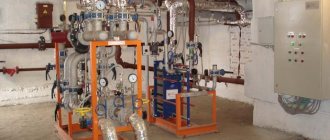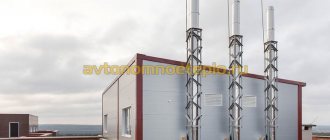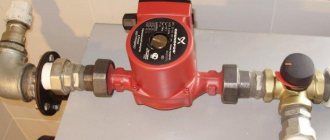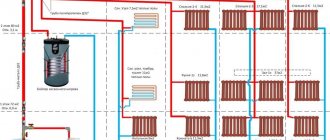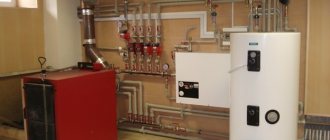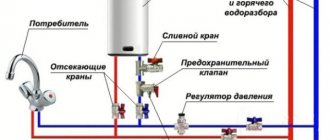Here you will learn:
- Disadvantages of gas heating
- Why services don’t like autonomous heating for residents
- Safety of gas boilers in apartments
- How to switch to gas heating
- Autonomous heating installation diagram
- Arranging a room for installing a gas boiler
- Requirements for chimney installation
- Gas boilers for heating an apartment - basics of choice
Before installing autonomous heating in an apartment, you need to know its main advantages. They are related to both operational and structural characteristics. The advantages are as follows:
- an autonomous gas boiler room reaches operating mode as quickly as possible;
- the real efficiency of most systems reaches 95%, which is one of the best results among analogues;
- compact dimensions allow you to fit everything in any kitchen or bathroom, without allocating a separate room for a gas boiler in the apartment;
- relatively cheap fuel is used;
- it is allowed to start autonomous heating in an apartment building at any convenient time when the owner needs it, in contrast to starting central heating according to the schedule;
- effective gas automation is used on an old or new boiler;
- quick payback.
A well-designed heating circuit will ensure a long period of uninterrupted operation.
At any time, the owner of an autonomous heating system in an apartment can increase/lower the temperature of the coolant independently in order to provide the home with heat or save on gas consumption. Using a double-circuit boiler, it will be possible to minimize the cost of providing hot water supply.
Disadvantages of gas heating
In addition to the positive qualities that the apartment owner receives individually, the heating system of the house as a whole receives a certain imbalance. This is due to the fact that a large residential facility was designed for operation with hydraulic equipment installed in it. In addition to problems with loss of thermal balance, physical violations of building codes and regulations during equipment installation are common.
The greater financial burden of maintaining heating mains or boiler houses falls on fewer people, which leads to an increase in the cost of central heating for them.
An imbalance leads to the fact that heating occurs unevenly in different apartments; in some places you can’t get close to the radiators due to the heat, and in others the sections are not warm enough. In addition to these aspects, air pollution is increasing. Every boiler releases harmful gases into the atmosphere, which leads to pollution. Often carbon monoxide can enter the room through an open window located next to the heating pipe.
Gas heating in an apartment in an apartment building is the best heating option combined with an affordable price and ease of operation of boilers. The main thing that is required from the consumer is to choose the right boiler, entrust its installation to specialists with a clearance category and carry out annual maintenance. For any problems with gas equipment, the appearance of uncharacteristic noises and especially odors, call the emergency service or invite a gas technician.
Independent installation
Naturally, before heating your apartment, you need to stock up on consumables and various tools.
In particular, this is useful:
- tow and silicone for sealing some joints;
- various fittings (adapters, angles, etc.), fasteners and dowels;
- plastic scissors;
- wrenches, screwdrivers (phillips and simple) and a hammer;
- pencil, tape measure, building level;
- upholstery cord or construction thread - these items are necessary for marking a line along the perimeter of the walls along which the main line of pipes will run;
- perforator and drill with a diameter of 6 mm;
- soldering iron for plastic.
Let's assume that the tools and materials are available. This means it is possible to proceed to the first stage.
Radiator installation
Everything is done according to approximately this scheme:
- Using a hammer drill, holes are drilled for hooks for bimetallic radiators. At the same time, make sure that between the holes there is as even a horizontal line as possible - use a level if you do not want the battery to hang crookedly.
- The hooks are driven in or screwed into the dowel until it stops.
- The radiator is hung on hooks.
The work is simple and simple, but it is fundamentally important to know about several nuances
- There should be a distance of at least 5 centimeters between the window sill and the top line of the radiator. If everything is “back to back”, there will be no high-quality upward air circulation.
- Make sure that the hooks in the dowels are seated as firmly as possible. If the fasteners hold loosely, then during pressure changes the battery may vibrate and simply “move away” from the wall.
We continue to do the heating of the apartment with our own hands - we move on to working with pipes.
Soldering the line and connecting to batteries
Essentially, it is necessary to create a line of two parallel pipes along the entire perimeter of the room. This will be the coolant supply channel and the so-called “return”. It turns out that the line will be connected to the point where the outlet from the central heating pipes is installed.
And in those places where a connection to radiators is required, tees will be built into the non-specialized pipeline, from which vertical sections of pipes will be installed. And the fittings connecting the system and batteries will be attached to the ends of these sections.
Everything is done quite simply.
Turn on the soldering iron and wait for min.
15 – it is fundamentally important to wait until it warms up well. Otherwise, the plastic will not melt as needed during soldering
We take the ends of the pipes and put them on the soldering iron nozzles. We wait about 4 seconds, remove the plastic from the nozzles and thread the pipes into each other. When inserting, it is imperative to make a certain effort so that the adhesion of the adhesion points occurs as effectively as possible.
- In places where radiators are installed, we solder fittings and tees into the pipes. Naturally, they must be placed on both the supply and return lines.
- In a similar way, we go through the entire perimeter and connect through fittings to the points of the central pipeline.
Now you need to connect the radiators to the main line.
To do this, we cut off pieces of pipes of the required height - the ends of these sections, and tees, must be melted with a welding gun and connected to each other.
Then we attach corners to the end of each vertical “rack”. We weld very small sections of pipes horizontally to these corners (their length should be exactly enough to reach the radiator holes).
And at the ends of these segments you need to solder fittings with the so-called “American ones” - these connections will be twisted specifically with the batteries.
Don’t forget that proper heating installation in an apartment requires that a coolant supply shut-off valve must be installed for each heater. And this, by the way, is done not only to eliminate emergency situations, but also for comfort and efficiency.
The fact is that with the help of such taps it is possible to regulate the power of the coolant flow, which allows you to regulate the temperature regime for one or another battery. Well, it goes without saying that the tap can be completely turned off in those rooms that, by and large, you do not want to heat.
After the pipeline is installed, it is necessary to perform a test run of the system and carefully check all connections for leaks. If everything is in order, then the system can be used normally.
This is the scheme of work. Now let's summarize the article.
Why services don’t like autonomous heating for residents
As a rule, all heat supply organizations are opponents of autonomous heating in apartment buildings, especially if from the very beginning the house was designed specifically for centralized heating. If one of the residents installs an autonomous boiler, this will unbalance the internal heating system of the entire residential building.
In addition, sometimes separating and installing your own gas heating in an apartment in post-Soviet countries is accompanied by violations of safety requirements and documentation.
As a result, it turns out that the one who separated remains in economic benefit, and the remaining residents only suffer from this.
One of the disadvantages is the violation of hydraulic balance. So, it turns out that in some apartments the rooms are very hot, while in others, on the contrary, they are cold. Therefore, heat engineers have to intervene and adjust the heating system.
In addition, there is also an environmental aspect. It is very good if individual gas heating in the apartment was installed in a building that has an old structure - that is, the presence of a chimney is provided. But in modern multi-storey buildings there is no such kind of ventilation: ventilation ducts are only in the kitchen and bathroom.
Autonomous heating in the apartment
Typically, residents install chimneyless gas boilers that have a coaxial pipe through the wall under the window. Gas combustion products are usually discharged through the pipe. And this leads to the fact that gas combustion products (carbon, carbon monoxide, a combination of sulfur, oxides) enter the apartment owner or his neighbors through the open window. Even though many modern boilers are equipped with a closed combustion chamber, this fact cannot be ignored.
Parapet boiler chimney
What to do?
Thus, each apartment owner independently decides whether to separate from the others or not. But if you can’t decide what to do in this case, then just think and weigh the pros and cons. If you have an old-style low-rise apartment building that is equipped with chimneys, then you can safely switch to autonomous heating.
Boiler room of an apartment building
If all your neighbors want to secede, then there may be two options. It is possible to carry out a major reconstruction of the house - equip chimneys and internal gas pipelines, and a complete heating system. This is a serious option that requires a lot of expense, but each resident will have their own boiler. Another option is installing a boiler room. That is, there will be one powerful boiler, for which there will be a special room. Residents only have to reconstruct the heating for this type of system and install meters. Although there will not be complete autonomy here, the main advantages are obvious: you set the temperature yourself and pay only for what you heat.
Safety of gas boilers in apartments
Nowadays, manufacturers offer many boiler options. If you follow the operating rules, then they are all safe. But every boiler that uses autonomous gas heating in an apartment is serious equipment that requires adjustment and constant monitoring of its operation.
Minimum requirements for installing a gas boiler
If your apartment does have a chimney, then after some time soot will accumulate there. It must be cleaned at least once a year. If this is not done, the efficiency of the boiler will significantly decrease and the release of substances will increase. For example, if a new boiler emits one of these substances, then one that has worked for several years without cleaning will already emit two.
Individual heating in the apartment
Today, each boiler is equipped with automatic combustion and safety automatics. The latter is designed to turn off the gas supply if the pressure is low, and after the pressure is restored, the boiler should not start on its own without purging.
It often happens that after several attempts an error is displayed. And if the boiler is relatively old, then such a system may not exist. Such a boiler will require ventilation and manual start. If the automation does not work, gas contamination of the boiler and room may occur. There are many organizations involved in the installation and maintenance of boilers, so you should not try to fix it yourself, even if you think you can see what is wrong or wrong.
How to switch to gas heating
The constant struggle with the problems described above forces you to take the first step towards installing an autonomous system. It makes sense to think in advance about how to install gas heating in your apartment in order to calculate the cost of purchasing equipment and get an idea of the upcoming work.
First, document that there are real problems. To do this, you need to submit the appropriate applications to your heat supplier and the sanitary and epidemiological station.
In most cases, heat supply organizations are against autonomous heating. Some houses were designed directly for centralized heating. Disconnecting residents from the system leads to system imbalance
These preliminary actions will help to challenge in court a possible refusal to install individual heating. Issues of this nature are often resolved in court.
To facilitate the process and gain confidence that you are right, you need to familiarize yourself with several regulatory documents.
For residents of the Russian Federation, this list includes:
- Federal Law 190-FZ “On Heat Supply” dated July 30, 2010;
- Decree of the Government of the Russian Federation No. 307, explaining the rules and features of the provision of utility services to residents;
- Articles 25 and 26 of the Housing Code of the Russian Federation: explaining the features of the reconstruction and redevelopment of premises in apartment buildings and the grounds for their implementation.
Judicial practice shows that there are many precedents for successfully challenging unfounded refusals.
Refusal from central heating supply
The text of Federal Law No. 190 specifies a list of individual heating sources that are allowed for installation in apartment buildings, as well as a list of devices prohibited for various reasons. The law, therefore, does not prohibit the use of modern gas boilers that meet the requirements.
To disconnect from the central system, you must prepare a lot of documents. Some owners are shocked by the time and amount required to implement their idea. Even though the fight will be difficult, autonomy is worth fighting for
According to Article 26 of the Housing Code of the Russian Federation, it is necessary to collect a whole package of documents to carry out the reconstruction of residential premises. This includes:
- A properly completed application for the need for reconstruction from the owner or responsible person;
- Original technical passport for the apartment;
- Copies and originals of notarized documents establishing the right to own and dispose of housing;
- The original of the developed project for the reconstruction of a residential apartment;
- Written consent of all family members and other residents registered in the premises;
- Conclusion of the authorities involved in the protection of architectural monuments on the admissibility of reconstructing the premises.
The structure providing central heating services has been considering the application for some time. It issues a letter with permission to disconnect the apartment from the central system. This document will be required when ordering technical specifications for the installation of individual gas heating within an apartment building.
The application for ordering technical specifications is submitted to the gas industry. The answer is usually given within ten days. A refusal can be obtained in cases where there is no gas in the region, it is impossible to purchase it in cylinders or regularly replenish the supply of blue fuel in the gas holder.
After formalizing the refusal of utility services in the field of heat supply, old and inefficient systems should be dismantled. To do this, you need to have a project to disconnect from central heating.
The basis for drawing up the project is a letter from the Homeowners Association with permission to terminate the use of the services of the heat supply organization. Be sure to receive a written response and save it. If you refuse this letter, you can go to court to appeal.
Having received the project documentation in your hands, you need to go with it to the regional branch of the All-Russian Voluntary Firefighting Society. After all checks, they issue a fire safety certificate for the project. If the need arises, a design for the chimney is also made there.
Sometimes the city administration delays the approval procedure. In this case, it is necessary to write an application addressed to the head of the administration to speed up the process. If after this you have not made progress, then consider going to court.
All documentation must be approved by the city administration. The conclusion on approval or refusal is accepted within forty-five calendar days from the date of its submission.
A refusal to renovate an apartment in an apartment building is issued on the basis of Article 27 of the Housing Code of the Russian Federation if the owner has not provided all the required documents. An unjustified refusal can be appealed in court.
Preparation of documentation and obtaining approval for the refusal of central heating supply. This is an initial preparatory step towards the legal transition to an individual gas heating system.
The list of required documents differs depending on the region and the specifics of the law. Comprehensive information can be obtained by consulting your city administration.
Permission to install a gas boiler
To successfully install a gas boiler, a number of formalities must be observed. First of all, you need to submit an application for the need to install an individual gas system in the city gas supply.
At the same time, you need to obtain a document confirming the serviceability of the ventilation and chimney. It is requested from the fire department.
Each neighbor must give their written consent to your desire to install an autonomous system. This measure is necessary due to the fact that when one or more apartments are disconnected from central heating, some malfunctions in the operation of the heating system may occur for the remaining residents of the house.
So, some apartments may begin to receive more heat, while others, on the contrary, less.
Installing a gas boiler without approval, technical specifications and design can lead to equipment damage, physical injury and litigation. Treat all gas appliances in your home responsibly
This problem is due to the fact that most heating systems in apartment buildings are outdated many years ago and require constant maintenance.
Next, you should recognize the manager by pipes and batteries. If they are managed by a household, then it is necessary to obtain permission for dismantling from neighbors. If they are subordinate to a government organization, then you need to write a statement to this company with a request to disable the systems.
After receiving all the documents and permits, you must contact the city heating network and get permission to draw up and approve a scheme for the future autonomous heating.
When the entire list of documents has been received and all previous stages have been completed, you can proceed directly to the dismantling of old communications. Typically, collecting the required papers takes from three to six months. Before submitting a technical certificate for the boiler to the gas organization, you should select the equipment model that is suitable for your apartment.
Boilers are single-circuit and double-circuit. Double-circuit gas units provide residents not only with heating, but also with an uninterrupted supply of hot water. This allows you to save gas and reduce service costs. Modern oversized devices have closed combustion chambers.
This design simplifies installation and eliminates the need for a gas duct. A special fan drives air from the street and then releases combustion products back through pipes installed for this purpose.
The design of gas boilers is light in weight and size. The boiler is installed on mounting strips on a load-bearing wall if all requirements for the room are met. Usually the boiler is connected to the gas main using metal pipes
The advantages of gas boilers include a multi-level security system, which includes an automatic system shutdown function. A number of sensors monitor the draft force and the presence or absence of flame.
A safety valve monitors the fluid pressure in the system and, if the norm is exceeded, is responsible for draining the excess fluid. The expansion tank allows you to control the expansion of the liquid when heated. The air vent is responsible for removing excess air from the system.
Sample list of documents
Since installing your own heating system refers to the refurbishment of a residential premises, the list will include:
- an application drawn up in a special form;
- documents establishing the right to own housing: state registration certificate, deed of transfer of ownership, gift agreement, document confirming the right of inheritance (originals or copies certified by a notary);
- certified copies for each owner and a statement signed by all owners (if the apartment is in shared ownership);
- a copy of the technical passport of the premises;
- consent of family members of the tenant and residents of the apartment building, documented in the form of minutes of the meeting of apartment owners (if the area is municipal);
- conclusion of the body responsible for the protection of architectural monuments, historical or cultural heritage on the possibility of redevelopment (if the house is an architectural, cultural or historical value).
The most difficult thing will be to prepare and provide technical documentation. These include:
- redevelopment project for the installation of a gas boiler, including gasification of the premises and changes to the central heating system;
- a copy of the passport for the electric boiler, technical conditions, agreement confirming the permission of the maximum power, which exceeds the capabilities of the boiler (when choosing an electric heating device);
- Specifications for disconnecting the wiring in the apartment from the communal heating system;
- Specifications for ventilation;
- Specifications for supplying gas networks.
Design and installation of an autonomous system
At this stage, the apartment owner, together with the designer, carry out the necessary calculations and decide what kind of individual heating system will be in the room. Depending on this, a gas boiler suitable in terms of power and characteristics is selected.
After installing a wall-mounted gas boiler, you should connect the coolant heating circuit to the installed heating system. The operation of the boiler is controlled by automation and a thermostat connected to it; the circulation pump built into the column is responsible for the movement of the coolant.
According to the rules, the required power is 100 W per square meter of area. This value is quite enough even for corner apartments, connected by many common walls with neighbors, which guarantees no heat loss.
The wiring, that is, the diagram according to which all heating devices and connecting pipes are located, depends on the type of boiler chosen and the principle of coolant movement: natural or forced. The layout is chosen at the design stage. It can be single-pipe or double-pipe, horizontal or vertical, top or bottom.
In addition to the diagram of the new autonomous system, the content of the project should include a section containing data on the dismantling of the old heating system. It specifies the details of disassembling and removing batteries and connections. It should be taken into account that the risers running through the apartment cannot be dismantled and must be insulated.
Before initiating a refusal from central heating and hot water supply, compare all the pros and cons of an individual system. Only after making the calculations, start collecting all the necessary documents
The individual heating scheme of your apartment must correspond to the possibility of installing radiators with thermostatic valves at the inlet. Conventional aluminum structures are suitable for this purpose.
If desired, the owner of an apartment on the ground floor has the opportunity to design a system of water heated floors simultaneously with autonomous heating. For owners of apartments located above, this option is not available, since the floors are not designed to support the weight of the system with coolant and concrete screed.
If the construction of a water floor heating system is approved, even on the first floor, separate procedures are envisaged to strengthen the lower floor by installing additional supports in the basement.
Perhaps after design it turns out that it is necessary to install new radiators. Despite the high cost of modern radiators, their quality plays an important role in the transfer of heat into the room. Therefore, it is better to choose high-quality models
If your home experiences periodic power outages, then you should consider purchasing an uninterruptible power supply. Thanks to the BPS, your gas boiler will work without interruption and continuously provide your apartment with heating and hot water.
Required documents
The law states that absolutely any home owner has the right to individual heating and disconnection from the central heating system.
To complete the procedure, the owner must provide:
- conclusion of an engineering company on the technical feasibility of re-equipment;
- written consent of all apartment residents;
- documents certifying the ownership of the apartment;
- technical passport of housing;
- a statement drawn up in free form.
The law also requires the provision of a project as one of the main documents in the package. The project is being developed by water and heat supply engineers.
It is also worth entrusting the project to specialists because, sooner or later, independent conversion will be fixed and dismantled with a return to the central heating center, it is good if this happens before the neighbors below are flooded due to improper wiring, installation or cutting of pipes.
The project is compiled exclusively by specialists who calculate the changes. The calculation determines what impact a future shutdown will have on the operation of the heating system in the house. In addition, specialists carry out thermal-hydraulic calculations and calculations of heat transfer from the riser.
Autonomous heating installation diagram
The installation of a gas boiler is carried out in compliance with certain requirements for its placement. So, it should not be closer than 20 cm from other household appliances or flammable materials (this distance can be greater (30-50 cm), which depends on the boiler model). Also, you should not place the heating device between walls or near a window, although the power source, on the contrary, should be as close as possible.
Important! As soon as you select a suitable location, be sure to check the purchased gas boiler for the presence of all fastening and additional elements: mounting templates, fixtures and brackets, because if they are absent, it will be problematic to make autonomous heating in the apartment using the same gas boiler.
In addition, be sure to compare the technical characteristics declared by the manufacturer (indicated on the packaging) with the values indicated on the identification plate located on the inside of the front cover of the boiler.
Before you proceed to installing the equipment, be sure to flush all the boiler pipes and the system as a whole, which will help remove foreign particles that often get inside the system during factory assembly.
The strips for mounting the boiler (included in the kit and fixed to the wall with anchors) are placed at a distance of 1.0-1.6 m from the floor. The wall must be level and strong enough, otherwise it will not be able to support the weight of the boiler and all related devices.
To prevent clogging of the heat exchanger, it is better to install an angle-type mesh filter at the water outlet. Ball valves are located on both sides of it, which will facilitate the maintenance and repair of the boiler in the future. After this, you also need to check the evenness of the equipment, because skew in any direction can cause extremely undesirable consequences.
At the next stage, as soon as the boiler takes its place on the wall, it is necessary to connect the heating and water supply system pipelines to it (before connecting the boiler to the water pipes, be sure to remove all plugs installed on the pipes). The connection between the boiler and the pipeline is made using polypropylene couplings, at one end of which there is a thread with union nuts, and the second part is soldered to the pipe.
Wall-mounted double-circuit gas boilers have 5 outputs:
- 1 – treatment, used to return cooled coolant from the heating system back to the boiler;
- 2 – supplies cold water from the water supply;
- 3 – gas tube;
- 4 – is responsible for the output of hot water for the water supply system;
- 5 – supply tube through which the hot coolant is directed into the heating system.
Important! For different boiler models, these tubes may have different locations, so to avoid mistakes, always study the technical documentation that comes with the boiler.
Single-circuit boilers have only 3 outputs: gas, supply and treatment.
Ball valves are installed on all boiler pipes, and they are present even where at first glance it seems that there are none.
The process of installing a wall-mounted boiler is described in great detail in its passport, so you can find answers to almost all the questions that you will have during the installation process in this manual.
But do not forget that only a specialist from the gas service can connect the boiler to the gas pipe. A gas tap or ball valve (certified only), a gas meter, a thermal shut-off valve and a gas alarm are installed in front of the boiler. It is necessary to ensure constant open access to the gas tap.
Remember! Connecting on your own is a very dangerous activity.
Project development and installation work
Installation of a new system begins with the dismantling of old heating equipment.
You need to plan a private heating system for an apartment taking into account its area and planning features.
The project must be done taking into account the following restrictions:
- moving the riser;
- removal of heaters to the balcony;
- demolition of the partition between the kitchen and living room;
- moving the bathroom.
When planning a strapping scheme, the choice is made from the following options:
- radiators - cast iron, steel, bimetallic;
- pipes - plastic, brass, steel;
- method - one-pipe or two-pipe;
- circulation - natural or forced;
- wiring - top or bottom;
- connection - vertical or horizontal;
- interchange scheme - with dead-end highways or throughways.
It is recommended to pour distilled water into the system to avoid scale formation.
The construction of an individual heating system is carried out in the following sequence:
- Dismantling of old communications. It is no longer advisable to use them; it is better to install new and more efficient ones. First, the batteries are disconnected, then the piping, and lastly the pipes near the riser. The holes are welded tightly or a pipe with a thread for a plug is attached to them. In some cases, part of the riser with bends is cut off and a new fragment is welded in its place.
- The boiler is being installed. If necessary, a stable base is made for it next to the external wall. Then the product is aligned vertically.
- Radiators are being installed. To fasten them, strong and reliable hooks with dowels or anchor products are used if the work is carried out in a brick building.
- The harness is being laid. Branches extend throughout all rooms. It is advisable to use reinforced polypropylene pipes, which have better characteristics compared to analogues. Assembly is carried out with a special soldering iron.
- Ball valves are installed in front of the batteries, after which they are connected to the supply and return.
- The tightness of the assembled circuit is checked. To do this, use a compressor with a pressure gauge or soap foam.
- The boiler is connected through a meter to the gas main. A shut-off valve is installed on the pipe.
- The circuit is filled with water. Air is released through Mayevsky's taps.
Arranging a room for installing a gas boiler
Separately, it is necessary to mention the premises of the apartment where it is planned to install gas equipment. The safety of the residents of the entire house will depend on its proper arrangement.
To place a gas boiler, you cannot choose an arbitrary room in the apartment, guided by some of your own interests. The premises must meet certain requirements, the list of which includes the following:
- The equipment cannot be installed in any of the living rooms of the apartment.
- The area of the room must be at least 4 m².
- The entrance door to the room cannot be less than 800 mm wide.
- The room must have a window facing the street.
- The unit is hung on the wall or installed on the floor, at a distance of at least 300 mm from another gas-powered appliance, for example, from a kitchen stove.
- It is not allowed to connect the chimney of a gas boiler, as well as the water heaters, to the general house ventilation system. The pipe must be led outside through an external wall. The most convenient way in this regard is to use coaxial chimneys with forced air injection and exhaust of combustion products.
- Some gas boilers with high power require the installation of forced ventilation in the room, that is, equipped with an exhaust fan. If the technical conditions for arranging a room for the installation of a specific boiler model indicate such a requirement, then you will have to install a fan of the appropriate capacity into the window.
- A wall-mounted boiler can only be installed on a wall made of non-combustible material. The floor area under the floor-standing version of the device is usually covered with ceramic tiles.
The kitchen area is still unfurnished, immediately after the completion of the installation of a gas wall-mounted boiler and the entire heating system.
If at least one of the requirements cannot be met, the commission that accepts the gas equipment will not sign the act of permission to put it into operation.
Based on the list of requirements, we can come to the conclusion that the gas boiler can be installed in the kitchen area or in the associated loggia. The loggia must be well insulated in advance. These rooms are most suitable for installing gas equipment, since the gas supply riser is traditionally located in the kitchen.
The kitchen area of the apartment must have a window facing the street, as well as a doorway of the required width. In addition, general house ventilation ducts pass through the kitchen, which are also necessary when arranging the room as a “mini-boiler room”.
Pipe selection
To save your own time and money, it is recommended that even when coordinating the project with the housing office, you think in advance which pipes will be used. Referring to the advice of experienced specialists, it is advisable to take pipes made of plastic or metal-plastic.
Copper, like steel, pipes are far from the best option for amateur beginners. They will require special handling, additional skills and, of course, special tools to be able to weld and cut parts.
- Plastic pipes are good because deposits do not appear inside them due to the quality of the water used.
- Low thermal conductivity allows you to provide rooms with heat for a long time.
- Pipes made from polypropylene can be called the best, based on the ratio of their price and quality.
Connecting them does not require any particularly complex skills, and it will not take much time to master the soldering iron needed to work with them.
Requirements for chimney installation
When installing a gas boiler of any type in an apartment in an apartment building, the chimney cannot be made narrower than its outlet pipe. If the device has an open combustion chamber and a power of no more than 30 kW, the cross-section of the chimney pipe cannot be less than 140 millimeters, and with a productivity of 40 kW - 160 millimeters in diameter.
If the boiler has a closed combustion chamber, it is equipped with a coaxial chimney with a cross-sectional size recommended by the manufacturer.
Next you need to adhere to the following rules:
- the pipe going upward from the wall-mounted gas unit must have a length of at least 50 centimeters, and only then can the elbow be installed;
- more than three bends cannot be created along the entire length of the chimneys;
- combustion products from appliances with open combustion chambers are removed into the chimney, and with closed ones, also into the chimney or through the wall directly to the street (the method depends on the project).
